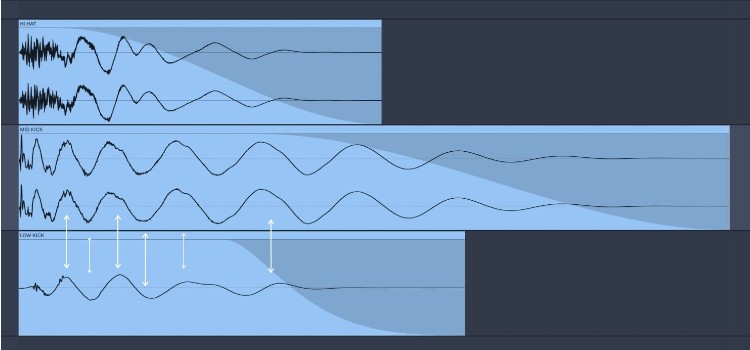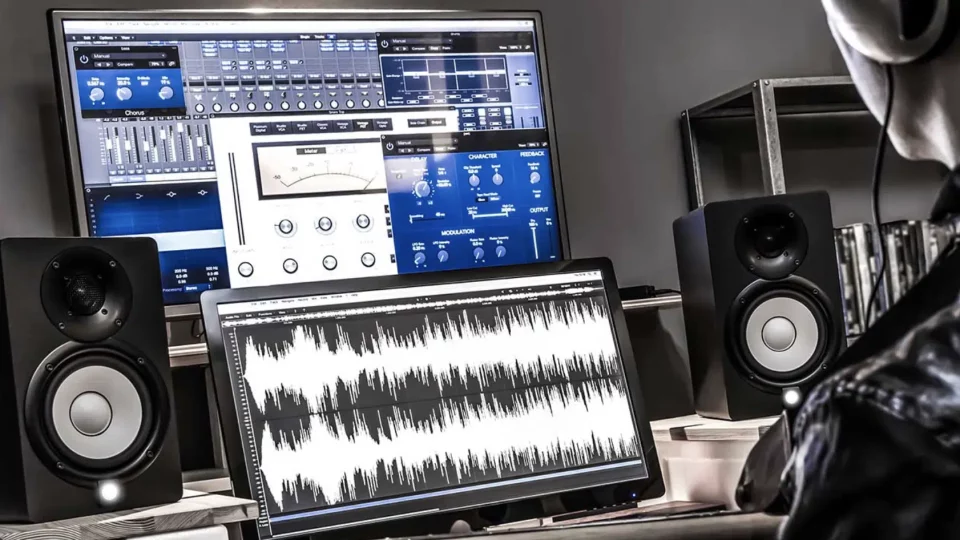Beatmaking 101 – Layering Beats
One of the most powerful tools in a producer’s arsenal is layering. Layering beats isn’t just about stacking sounds for the sake of it. Done well it can create depth and complexity as well as offer extra possibilities in the mixing process.
In this post, we’ll demonstrate how you can use layering to transform your beats. We’ll explore different techniques for layering drum elements, ambient sounds, melodies, and textures, so your beats stand out from the rest.
What is Layering
Layering in beatmaking refers to the stacking of two or more audio elements in order to create a fuller, richer sound. Effective layering involves careful selection, blending, and balancing of these elements so they perfectly complement and enhance each other.
When you layer effectively, each sound has a purpose. Your goal is to make the beat sound more immersive, and rich. It is a little like cooking. A single ingredient might taste bland on its own, but when combined with other complementary ingredients or spices, the dish can become a triumph.
Why Layer?
Layering does more than just add volume or density to a beat. It can give the illusion of space and movement as well as adding interesting textures. When done well, it can make each element of your beat—be it a drum hit or melodic element, sound more vibrant and interesting. Layering can also help to control the mix. This is done by occupying different frequency ranges within a beat. This can help to create a sense of fullness without overcrowding the mix.
For instance, consider a simple kick drum pattern. On its own, it may lack the presence to cut through. By layering it with another kick or percussive sound, you can add more punch or low end, therefore creating a phatter sound.
Layering Drums

When it comes to your beats, regardless of genre the drums often carry a track. If your drums and rhythm section is punching through and sounding full and balanced everything else should fall into place. So let’s look at the various elements of the drum kit.
Kick Drum Layering
The kick is the driving force of most beats. A single kick sample often lacks the fullness or punch you need. By layering kicks, you can create both a powerful low-end and sharp attack. This will help your kicks to cut through the mix, especially when tuned to the key of a track.
For example, a clean, deep kick will handle the bass frequencies while a shorter, punchier kick might handle the mids. The result is a layered kick that hits hard but doesn’t overwhelm the mix. The trick is to make sure these layers are complementary. Tuning them so they sing well can help. You don’t want two kicks fighting for frequency space. Experiment with EQ by cutting the low-end out of the second kick or using a transient shaper to avoid clashing.
If you are using a vintage-style drum break the chances are your drums, especially your kick drum, will be slightly lacking in certain frequency domains. Layering can solve this by making up for any lacking sub or punch. This should enable you to maintain a more neutral EQ curve on the lead break drum(s).
Snare and Clap Layering
Snares and claps are another critical drum component that can benefit from layering. Where a kick drives a beat a good snare can provide character. A snare alone can often sound flat on its own. Layering it with a clap, rimshot or percussion sample, can impart it with more character and originality. Adding a reverb tail to snares can also add depth and flavour. The drum tracks on Portishead’s debut LP Dummy are a great example of this.
Like all layering the key is not to layer two sounds with the same qualities. Look for a weakness in a sound and compensate for this with a layer that represents the weakness. So in the case of a snare layer if you have a tight, punchy snare experiment by layering more ambient snare sound that have some reverb or decay. This creates a contrast between the transient attack and the tail of the sound. the result being a bigger more complex snare sound. Additionally, adding layers like a clap or snap can create a more organic feel. And for an even more natural sound try layering with a subtly different sound for each snare.
Hi-hats and Percussion
Hi-hats and percussive elements play a crucial role in shaping the groove or swing of a beat. To add complexity, you can layer different hi-hat sounds—such as a closed hat and an open hat or shaker. For example, you can have a steady closed hat playing on 8ths or 16ths. Then layer in a longer, open hi-hat on every other hit to add variation.
Another way to introduce complexity is by layering subtle percussive sounds beneath your hats, such as small clicks or shakers. These tiny accents might not be noticeable on their own, but they can add valuable texture and character. They can also help with frequency enhancement by adding shininess and sparkle to your hats, especially if the lead hat is slightly dirty or muddy.
Melodic Layering

While drums and bass provide the backbone of your beat, melodies are often the elements that give your beats emotion and feel. Layering melodies requires thought and finesse to avoid clutter. If done well, layering can transform a simple loop into a lush, intreaging composition awash with originality. So, let’s take a look at a few cases where layering can be used effectively to elevate your beats.
Chord layers
Chord progressions serve as the backbone of many beats. While a chord progression played with a single instrument can sound fine, layering multiple instruments or synths playing the same progression can create a more immersive and interesting sound. Each instrument or synth brings a tonal quality of its own. This can help the chord progression feel fuller and more engaging. This is especially the case when you start to introduce panning to the different instruments.
Example
Start with a vintage Fender Rhodes instrument playing a simple four-chord progression. It might sound nice on it’s own but a little uninspired. Next, layer a warm synth pad underneath. Make the pad lower in the mix. Its job is to fill out the harmonic space. Next, you could add a subtle plucked string or guitar line as your top line. You may want to use an arpeggiated feature playing the same chords to introduce a sense of movement. Remember, each layer adds something unique. You get richness from the pad, rhythmic definition from the plucks, and a smooth attack from the electric piano.
The key to layering chords is not to overdo it. You must be aware of the frequencies at play to avoid the overlapping of too many sounds. EQ can be effective in carving out space for each layer. For instance, cut some of the low mids from the piano or plucks if they start to compete with the synth pad. The goal is to give each layer its own sonic space to sit in while still contributing to the overall harmonic richness and character.
Counter-Melodies and Harmonization
A great way to add complexity to a beat without overcrowding it is through counter-melodies. So what is a counter-melody? It is a secondary melodic line that plays alongside the main melody but in a way that complements rather than competes with it. Unlike some of the other layering techniques discussed, counter melodies require new midi to be recorded rather than a different sound simply being triggered by the same note.
A good counter-melody can add a whole other dimension to your beat. It can vary throughout a track in order to keep the listener interesting and engaging over time. They can also be bought in and out which provides added scope for arrangement.
Creating Counter-Melodies: First, identify the key of your main melody or chord progression. Your counter-melody should stay in the same key. The idea is to play around with different note intervals and rhythms to create contrast. For example, if your main melody is smooth and slow, you could introduce a faster, more rhythmic counter-melody. This could add energy and excitement to the beat.
Experiment with layering different instruments for these counter melodies. For example, you could have some washy strings playing the main chord progression and a plucked sound playing the counter-melody. Make sure to pan them slightly to different sides of the stereo field. This gives both melodies space to breathe and prevents them from fighting for space.
Lead Layering

A lead sound can often make or break a track, especially in genres like trap or EDM where the lead line plays a prominent role. By layering multiple leads, you can create more impactful and original sounds. Moving away from predictable stock leads could give you a distinct advantage over your competition.
Example of Lead Layering: Let’s say you have a synth lead carrying the main hook of your track. Start by duplicating the lead track and applying a different sound or patch to the second layer. This could be a slightly more distorted or detuned synth. Now, you’ve got two synths playing the same melody but with different tonal characteristics. The result is often a much fuller and phatter sound.
And why stop there? Try adding a third layer, such as a vocal sample or guitar lead playing the same melody an octave higher. This higher octave layer should help the lead cut through the mix without overwhelming the other instruments.
As with chords, use EQ to carve out space for each lead sound. A build-up of any one frequency range using two sounds could potentially throw the subtle sonic balance of the lead.
Using Textures and Ambiences

Layering isn’t just limited to drums and melodic elements. Adding textures and ambience to your beats can take them to the next level. Think vinyl crackles, rain sounds, wind, or even field recordings like street noise. These layered elements generally sit in the background but their impact can be massive. Such textures can help to impart a sense of emotional depth through nostalgia or familiarity.
For example, laying down a subtle rain sound beneath a moody trap beat can evoke a melancholy or introspective vibe. Lofi is famous for its use of such layering techniques. Vinyl crackle for instance can give lofi beats their vintage feel.
The key with Ambience and texture layering is subtlety. These layers shouldn’t dominate the track, but rather enhance the atmosphere and provide a sense of space. Synth pads and drones can also be layered to add a sense of depth. Industrial electronic beats heavily rely on such techniques. These subtle layers can also act as a means to fill the empty spaces in a beat. They provide a subtle sonic cushion for the other elements. When using textural layers in this way sidechain compression can help to carve out space. Drums for example can be used to duck the volume of the texture when triggered.
Using Effects and Automation on Your Layering
Another way to add even more complexity to your beats is by using effects and automation to manipulate your layers. Be it drum, melodic or textural layers, effects such as reverb, delay, phasers and filters can help create a sense of space and movement. Add automation into the mix and you really can bring your layers to life. The layers become part of your overall arrangement by evolving throughout the track. An automated Wha-Wha filter effect for instance is a great way of adding flavour and life to a lead or chord progression.
Applying automation and effects to your drops is another fantastic way to add impact. For example, slowly build the volume of a pad or synth layer to build tension and release.
Avoiding Over Layering
While layering can add incredible depth and complexity to your beats, it’s important to know when to stop. Too many layers can risk a cluttered unfocused sounding mix. Too many different layered elements all competing for attention can quickly lead to a muddying of the overall sound. The key to successful layering is balance and subtlety.
Remember, not every sound needs to be layered. You should identify the most important elements of your beat and focus on layering those. Or target the sounds that are somewhat lacking and use layering as a way for them to reach their full potential.
And finally, always be aware of the frequency field when layering sounds. It’s easy for certain frequencies to build up when layering and cause a muddy or overly dense mix. Avoid overboosting and instead focus on Subtractive EQ. This will be a more controlled way to carve out space for each layer. For example, if you’ve layered a clap with a snare, try cutting the low frequencies from the clap to avoid clashing with the snare’s body.
Summary
Ultimately, layering is about experimenting and trusting your ears. Don’t be afraid to try unconventional combinations. These can often lead to original and unexpected results. The goal is to create a beat that feels full of depth and complexity, but at the same time be balanced and clear. By approaching layering with intention, you’ll elevate your beats to new levels, creating immersive soundscapes that will help set your beats apart from the competition.
Remember – RouteNote Create subscriptions start from as little as $2.99. You also get 10 FREE credits to spend on samples along with access to our FREE sample pack bundle when you sign-up!
